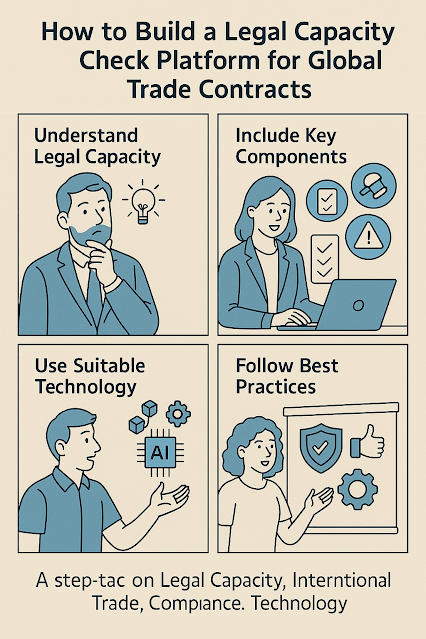How to Build a Legal Capacity Check Platform for Global Trade Contracts
Table of Contents
- Understanding Legal Capacity in International Trade
- Core Components of a Legal Capacity Check Platform
- Technology Stack and Tools
- Best Practices for Implementation
- Conclusion
Understanding Legal Capacity in International Trade
Legal capacity refers to the ability of a party to enter into a binding contract.
In international trade, ensuring that all parties have the legal capacity is crucial to enforceability.
Factors affecting legal capacity include age, mental competence, and legal authority.
For instance, minors or individuals with certain mental impairments may lack the capacity to contract.
Understanding these factors helps in assessing the validity of international trade contracts.
Core Components of a Legal Capacity Check Platform
A robust legal capacity check platform should include the following components:
- Identity Verification: Ensures that the parties are who they claim to be.
- Authority Validation: Confirms that the individual has the authority to bind the entity.
- Jurisdictional Compliance: Checks that the contract complies with relevant laws.
- Risk Assessment: Evaluates potential risks associated with the contract.
These components work together to ensure that contracts are legally enforceable and compliant with international standards.
Technology Stack and Tools
Building a legal capacity check platform requires a combination of technologies:
- Blockchain Technology: Provides a secure and immutable record of transactions.
- Artificial Intelligence: Assists in analyzing legal documents and assessing capacity.
- APIs: Facilitate integration with external databases for identity and authority verification.
Utilizing these technologies enhances the efficiency and reliability of the platform.
Best Practices for Implementation
When implementing a legal capacity check platform, consider the following best practices:
- Compliance with International Standards: Ensure the platform adheres to global legal requirements.
- User-Friendly Interface: Design the platform to be intuitive and accessible to users.
- Regular Updates: Keep the platform updated with the latest legal developments.
- Data Security: Implement robust security measures to protect sensitive information.
Adhering to these practices will contribute to the platform's success and reliability.
Conclusion
Developing a legal capacity check platform is essential for ensuring the validity of international trade contracts.
By understanding legal capacity, incorporating key components, leveraging appropriate technologies, and following best practices, businesses can create a reliable and efficient platform.
This will not only enhance legal compliance but also foster trust and transparency in global trade.
Key Keywords: Legal Capacity, International Trade, Contract Enforcement, Compliance, Technology Integration
Learn More about Contractual Capacity
Global Trade Compliance Solutions
This blog post offers insights into getting loans and mortgages in specific U.S. cities.
This blog post offers insights into getting loans and mortgages in specific U.S. cities.
This blog post offers insights into getting loans and mortgages in specific U.S. cities.
This blog post offers insights into getting loans and mortgages in specific U.S. cities.
This blog post offers insights into getting loans and mortgages in specific U.S. cities.

